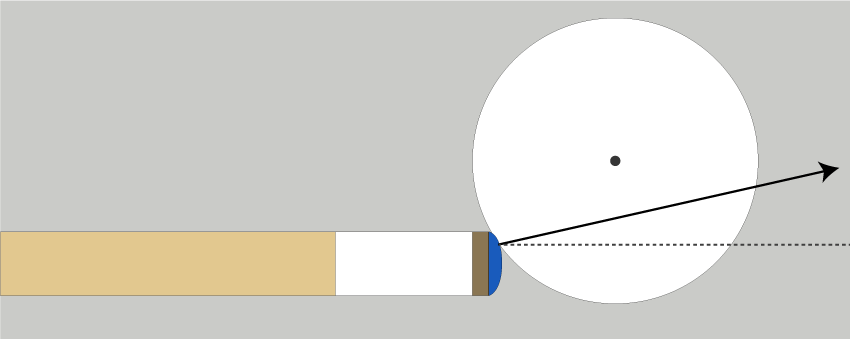Applying forward and backward spin will help you get position on most shots, but there are times where even those types of spin aren’t enough to get accurate position on a shot. Sometimes you need to alter the angle of a shot off of a rail in order to get a better shot. This is where left and right spin(english) can help. English is mainly used for shots where you use rails to get better position. When the ball has left or right spin on the cue ball it will change the direction the cue ball goes off the rail.
Here are some of the uses for english:
- Creating larger or shallower angles off the rail
- Playing more rails to get position
- Using swerve to get around another ball
- Using throw to change the direction of the object ball
Some Caveats
Even though you will find that english adds a whole new dimension to your game there are many factors that make using english difficult as it can take years to get fully accustomed to.
Swerve
In a perfect world putting on left and right spin would have no affect on the cue ball and playing pool would be a sinch for young and old and we would all sit around campfires singing coombaya. Unfortunately it is not a perfect world so we’re all going to need to buckle up and get used to an effect called swerve on the cue ball. When you put left or right english on the cue ball the friction between the cloth and the ball can cause the ball to bend out and then back in depending on how far the shot is taken.
So for long shots when your are using left or right english you need to account for this change in direction by the cue ball in order to make the shot. Depening on how comfortable you are in prediction how much the cue ball’s path is going to bend will dictate whether or not you use english on that particular shot. Keep in mind, the amount of swerve can change depending on whether or not you are elevating your cue and hitting the ball at a downward angle which will make the ball swerve more severely. That is why jacked up shots are so much more innacurate than keeping a level cue.
Squirt
When you hit the cue ball with english you are not hitting in the center of the cue ball and since the cue ball is round doesn’t come off the cue stick in a completely straight line. When the tip hits the cue ball the cue ball will deflect off the tip in a slightly different direction than it was struck. This means that when using left or right spin you will have to compensate for how much the cue ball will deflect or squirt. The direction where the cue ball squirts/deflects in a slightly different direction is dependent on which side you hit the cue ball. If you hit the ball on the left it will deflect right and vice versa if you hit it on the right side. This is dependent on how far from the center you are hitting the cue ball and also whether or not you have a cue stick that tries to minimize squirt, which is called a low deflection shaft.

Here we can see that even though we are hitting the cue ball stright while applying right english the cue ball wants to go left. This is because of deflection, and even though it is difficult to percieve it is defintely something to look out for. There are a lot of writeups about deflection, but Kamui Tips has the simplest writeup that’s eassy to understand.
The reason the ball deflects is because even though most of the power of your shot will drive it in the direction you hit it with you cue, some of that power will push the cue ball to the opposite side you hit the cue ball and away from your tip because it was not hit straight. Low deflection shafts try to curb this result by getting rid of the weight at the front of the cue which causes a lot of the deflection in cue sticks. This causes the end of the cue to deflect the cue ball less because there is less mass pushing the cue ball.They do this by using different materials for the ferrule, hollowing out most of the ferrule, or using a shorter ferrule to name a few methods.
Throw
When the cue ball and object ball make contact when the cue ball has spin some of that spin actually changes the direction of the object ball. This is possible because the friction between the two ball is enough to throw the object ball slightly at a different angle. The amount that the balls change direction can change depending on how fast the cue ball is hit and how much spin is on the cue ball as well. The max amount of angle that throw can change the direction of the object ball is about 5 degrees
The effects of throw can be useful though, for shots that would not be possible to make can actually be made sometimes using throw. In fact a common shot is to use throw to make a ball that cannot be fully seen by the cue ball because another ball is blocking it. Knowing how to use throw and when you can use it to your advantage will help you improve your game drastically.
